Driving the Brilliant 1990 Mercedes-Benz 190E 2.5-16 Evolution II
Few cars are as blatantly outrageous as homologation specials. That’s my first thought as I gaze at the massive wing and aero-sculpted fender flares of the 1990 Mercedes-Benz 190E 2.5-16 Evolution II before me. One of 502 examples built to push through a host of go-fast bits that Mercedes hoped would help secure the German Touring Car (DTM) championship, this Evo II is as garish as a base 190E is staid. But, as I’d soon discover, to judge the Evo II by its looks alone misses the happy dissonance that makes this particular Mercedes so special.
As I walk toward the driver’s door, my first-impression incredulity mixes with the mythology that has long surrounded this car—how the original 190E 2.3-16 prompted BMW to create the M3, the ensuing knockdown drag-out battles, and the eventual DTM championship captured by Klaus Ludwig behind the wheel of an Evo II—to create some pretty lofty expectations of what it’s like to drive. The Evo II might not be my hero car, but it’s a hero car to many, and I’m about to meet it.
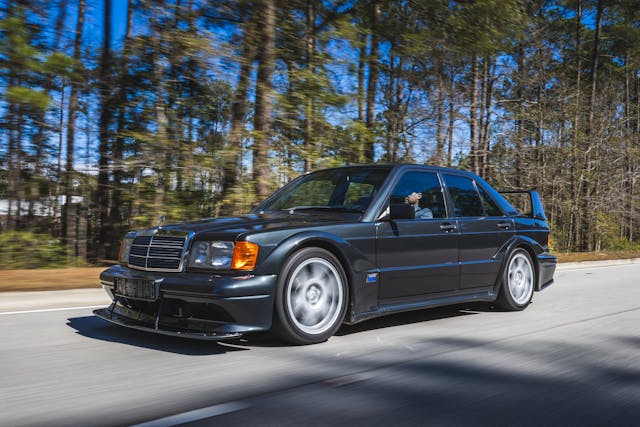
Before delving into the drive, though, a bit on the Evo II’s background…
The 190E, which debuted in 1982, owed its existence to the then-new U.S. Corporate Average Fuel Economy standards: Mercedes-Benz needed a smaller, more efficient model to help boost its fleet’s economy. To that end, the Bruno Sacco–designed small Merc was a departure for the company, but a necessary one if it wanted to play in the growing U.S. luxury segment. Despite its size, the W201 (the 190E’s internal chassis designation) adhered to the safety, durability, and luxury standards applied to Mercedes’ full-size cars. Multilink rear suspension—an industry first—contributed to the baby Benz’s handling and stability, and the platform itself was inherently robust. It was an excellent foundation for a small luxury car, but also an ideal starting point for racing.
Though the company refrained from factory participation in racing, a decision that came out of the tragic crash at Le Mans in 1955 that killed 84 people, Mercedes had planned to make the 190E available for privateers in the World Rally Championship. The Audi Quattro’s all-wheel-drive dominance rendered the Benz’s rear-wheel-drive configuration obsolete before it could even enter that series, however, and the company decided to turn to German Touring Car racing. There was one catch—the 190E’s M102 2.3-liter four-cylinder engine’s 136 horses didn’t exactly set the world alight.
To wake up the engine, Mercedes turned to Cosworth, which developed a 16-valve head that upped power significantly, to 183 hp in Europe and 167 in the U.S. The car now had the motivation it needed to take to the track, but to complement the newfound power and round out the new 190E 2.3-16 package, the car received a wealth of additional upgrades. Subtle bodywork tweaks reduced its drag coefficient and lift, and a dog-leg five-speed Getrag manual was fitted, as was a limited-slip differential. Larger sway bars, along with stiffer springs and dampers, made up the major suspension changes, and the steering ratio was quickened.
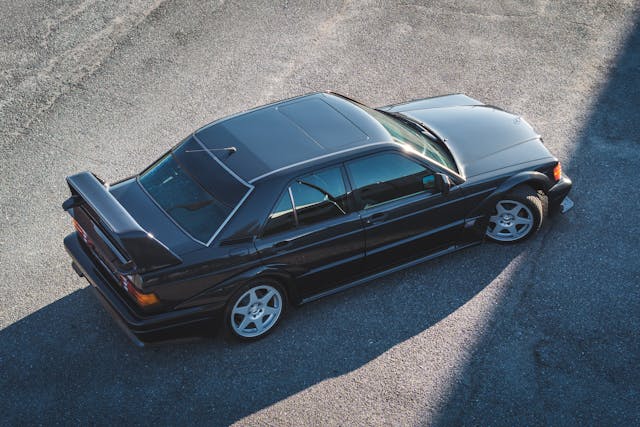
Privateers took the 2.3-16 DTM racing beginning in 1985 and met with some success—not championship-caliber results, but enough, evidently, to convince BMW to get in on the game. In 1987, BMW rolled out its M3 with full factory support. This move prompted Mercedes to finally get off its duff and commit to its own works effort.
Mercedes debuted the 190E 2.5-16 Evo I in 1989 and quickly sold 502 copies to make it racing-eligible. The larger 2.5-liter engine produced 201 hp, wheel diameter went up to 16 inches to accommodate larger brakes, and the steering got quicker still. The Evo I’s body wore larger fender flares and a more aggressive rear wing, though it wasn’t nearly as dramatic as what was to come. These tweaks still weren’t sufficient, however, as Audi, too, had joined the DTM, and competition was getting ever more heated.
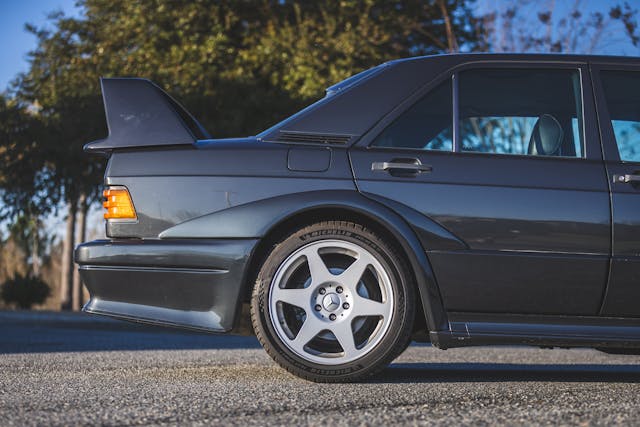
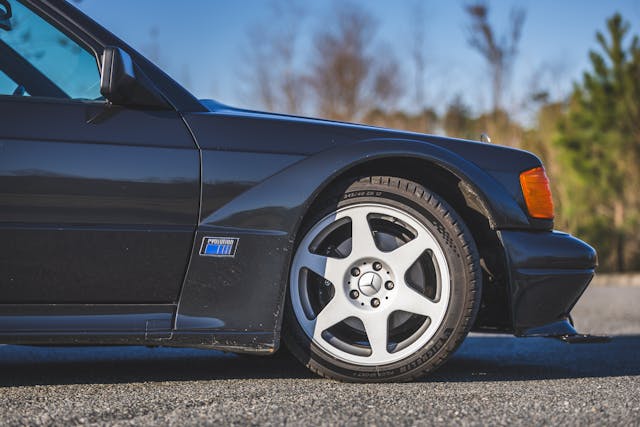
As a result, in 1990 Mercedes introduced the Evo II, the ultimate homologation iteration of the 190E. Revised induction and exhaust, improved engine management, and a 7800-rpm redline yielded 232 horsepower, while 17-inch wheels found their way to all four corners. The biggest change, though, was to the bodywork. The teardrop-look fender flares don’t exactly fit with the Sacco design, and the wing out back looks like a ’90s German interpretation of a Plymouth Superbird. But the important thing was that it worked; the car’s drag coefficient was just 0.29, and Mercedes had the tweaks it needed.

Given the fierce competition, it took a couple years of campaigning, but 1992 would be the 190’s year. In the hands of driver Klaus Ludwig, the Evo II brought home a championship for Mercedes.
More than 30 years hence, the Evo II remains revered. But why? Rarity doesn’t automatically make something special, nor does it guarantee a rewarding experience, especially in the case of limited-run specials primarily designed to get the racing program what it needed to win. With that question in mind, I pulled at the Merc’s door handle and slipped inside.
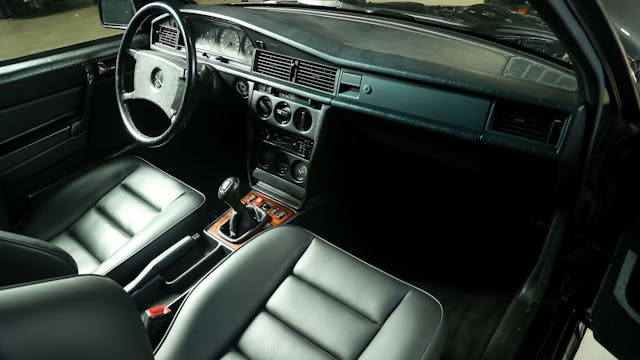
With the door closed, it’s easy to forget you’re in a homologation car. Everything presents as very standard 1980s-era Mercedes, with materials and finish that reinforce the solid, durable reputation these cars have always enjoyed. Then you look around and begin to notice the details: The bolstered seats look a touch out of place in the otherwise sober interior. The familiar gauge font displays a rather un-Benz–like 7800-rpm redline, and the shifter shows a dog-leg five-speed pattern. Tiny, aero-prioritized side mirrors sprout from the base of the front door windows—the left rectangular, the right smaller, stubby and square, with just enough reflective material to flash the presence of someone diving next to you into a corner. Look through the rearview mirror and you’ll see the window cover that reduces what’s visible out back—DTM rules specified that rear wings couldn’t block the field of view, so Mercedes’ solution was to effectively reduce the size of the window to hide the wing. Clever.
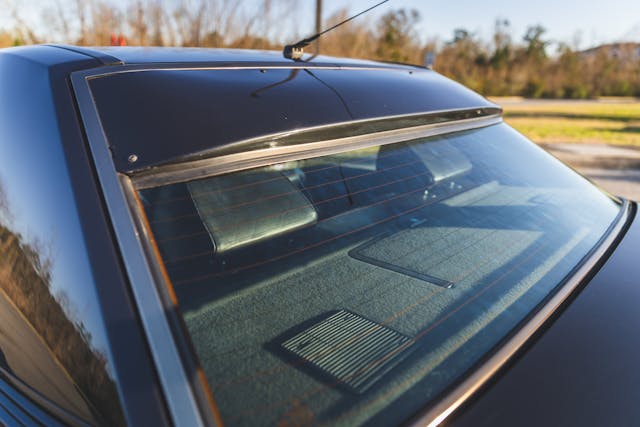
I pull the shift lever toward me and down to engage first. The dog-leg ‘box only takes a moment to get used to, and while the one-two shift is clunky—this is no drag racer—having second and third in alignment makes for straightforward gear changes, and surely helps minimize the potential for money shifts on track. The slide between gates is slightly stiff and the action is somewhat plastic-y, but it’s precise and never feels dainty or fragile. At speed, a healthy rev match helps smooth out notchiness during downshifts.
On the note of rev-matching, the pedals are well-spaced and the footwell offers plenty of room despite the car’s diminutive size. Clutch take-up is smooth, the grab point rather broad.
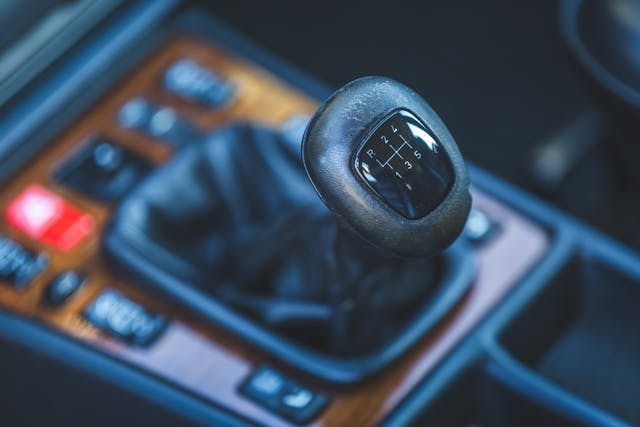
Once underway, the car immediately feels small—tiny, even. The short dash and upright windscreen, low window-sill height, and short hood punctuated by the three-pointed star at the front all contribute to a feeling of taut dimensions. Visibility is excellent, with the exception of what’s behind you, of course.
A couple miles into my journey, the dissonance begins to take hold. The Evo II does regular car things exceptionally well: It cruises over expansion joints without a care, idles smoothly, and sounds sporty, if not overly eager. This is not the manic, high-strung car the exterior suggests, and I’m reminded that no matter how exotic “homologation special” may sound, the competence of the platform underpinning it still goes a long way toward determining a car’s personality.
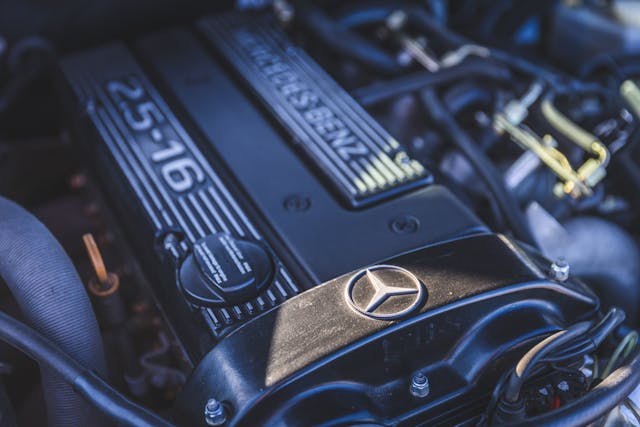
Then I lean into it and immediately see what the fuss is about. Around 6000 rpm, the induction noise comes alive, a guttural four-cylinder inhale that only gets better as the revs increase. The engine has plenty of torque lower down, but it wants to play up high and barely lets up by redline. The shifter seems to improve under increased urgency. The suspension setup, soft by today’s over-sprung standards, deftly controls body roll and isn’t the least bit flustered through mid-corner undulations.
It’s the steering, though, that’s the star of the show. Deceptively light, you could be tricked into thinking you were piloting a mid-engined car based on the steering’s weight and the degree to which it communicates. Though Mercedes quickened the steering incrementally from the 2.3-16 to the Evo I to the Evo II, it’s not so sharp as to be twitchy, and paired with the ever-composed suspension, it makes for what might be the most dialed-in, communicative front end of any front-engine car I’ve ever driven.
The beauty of the Evo II lies in its deftness; it’s not a monster you have to wrangle. It’s utterly balanced—communicative but not frenetic. Intense for how engaging it is, but not physically demanding. It asks for your skill, not brute force, and because of that, it’s the kind of car you could drive hard and enjoy for hours on end. And, not that you would, but you could easily daily an Evo II—it didn’t sacrifice any of its abilities as a means of transportation to become one of the most rewarding sport sedans in history.

Unfortunately, there’s a price for this level of fun, and it’s not cheap. Although the Hagerty Price Guide does not carry the Evo II, we do track their sales. Given their comparative rarity, they naturally come up for sale less frequently than their predecessor, the 2.3-16: Over the past five years, 24 Evo IIs have sold at auction, compared to 60 transactions for the much more common 2.3-16. The average transaction price for an Evo II during that time period is $296K. For context, a #2 (Excellent) condition 190E 2.3-16 comes in at $50,800. Values for this platform as a whole are on the rise, however, with the three-year change for the Evo II coming in at +9.7 percent, while a #3 (Good) condition 2.3-16 is up 2.4 percent (and 10 percent since the beginning of 2024).
The peak of the DTM-influenced 190E spectrum is rarefied air, and prices of top-flight examples began to ramp up their trajectory in 2022. The 2.3-16 that Niki Lauda piloted at the 1984 Nürburgring “Race of Champions,” for example, fetched $344,102 at a 2023 RM Sotheby’s sale. A famous butt in a seat couldn’t trump rarity, though, as a 3317-mile pristine Evo II sold at the end of 2023 for $544,000.
Expect this trend to continue for the Evo II, even against market headwinds. The collector status of homologation specials, particularly those from the ’80s and ’90s, is becoming more firmly ensconced with each passing year. Demographics help that cause—72 percent of buyers seeking quotes for the Evo II are Gen X or younger.
Outrageous as it appears, the Evo II’s clinical execution offers a near-perfect drive that I won’t soon forget. This car sits at the confluence of rarity and experience, which has solidified its collector status without question—here’s hoping those fortunate enough to afford one don’t hesitate to put it to use.
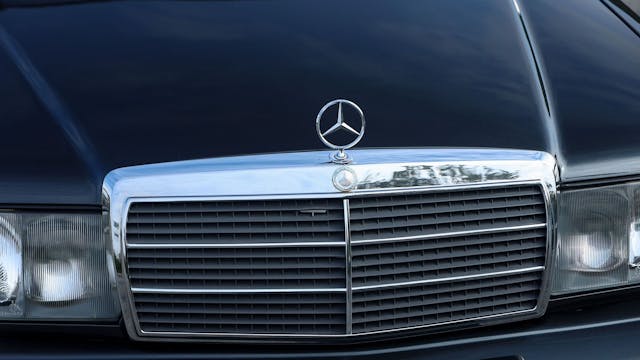
***
Check out the Hagerty Media homepage so you don’t miss a single story, or better yet, bookmark it. To get our best stories delivered right to your inbox, subscribe to our newsletters.
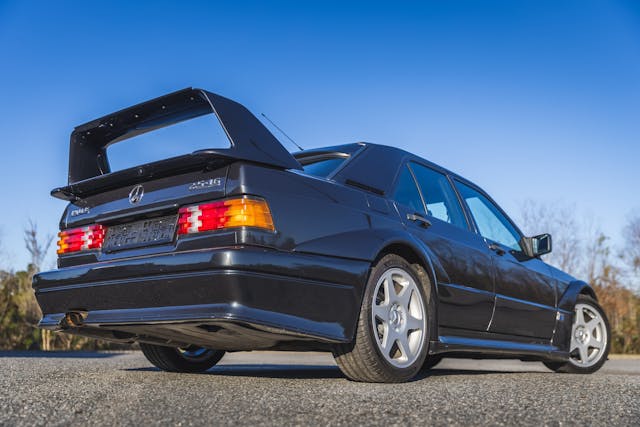


One of my favorites. An analog era that will never return. In this case I would judge it by the cover as I like it. I would love to drive one but that will likely never happen.
A college friend, the son of old Chicago money (think, folks own skyscrapers) had one of these in the same funeral black. I was allowed to drive it because I taught him to 1/4 mile in my ’66 GTO, and coached him on the sport bike thing with my Honda 900F.
It’s been decades, but I remember; everything the author wrote is factual. I’d kill to have one of these; the one I drove lives in a climate controlled garage-mahal in Chi, and is no longer driven. Ever. Sigh. I wonder if cars made to be hammered feel sad, that they are worth too much to fulfill their mandate.😿
The rear wing is a bit much for a street Merc . How hard would it be to unbolt that? Better to box it up and save it for posterity. The front air dam extension too and more so. That thing has cracking sound when I pulled into the parking space written all over it. I could learn to live with the fender flairs especially with a ‘peppy’ 200 horsepower that Cosworth had rubbed on mated to a 5 speed.
Reading my mind, Paul. or just massaging a 2.3-16 to get most of the way there…
” Great minds think alike” or.. in this case…on my end…” Birds of a feather flock together. ” I’d spend way too much on custom C-O-S-W-O-R-T H – Mercedes valve covers.
ps – If i had the time and the resources…an early (lightweight) dull beige Pinto with the later cooled 2.3 turbo 5 speed swap. I’d love to see that off centered but functional SVO scoop on the hood. Those rear leaf springs will have to go. We’ll have to get to that.
Thanks Eddie for this insightful article. If I may, what would be your advice for a regular 190e 2.5-16 with manual dogleg transmission (not EVO)?
Sell, keep stock, or modify?
Amro, Thanks for reading!
I think that comes down to your goals. I can’t leave well enough alone, and after driving the Evo, I found myself talking with colleagues about whether a 2.3-16/2.5-16 could be tweaked to attain most of what the Evo offered, and if it could be done using factory parts. Ultimately, if I had one, I think I’d uprate the suspension but retain the original components.
Values are up for cars in #2 and #3 condition, and while these cars will always be revered, I’m not sure they will ever get truly expensive.
My take is that the 2.3/2.5-16s are the perfect emerging classics to hang onto and use regularly. Whether you want to modify is up to your tastes.